Catamaran vs Monohull: Let’s Solve This (we Lived on Both).
This post contains affiliate links. As an Amazon Associate I earn from qualifying purchases. When you make a purchase using one of our links, I may earn a small commission at no additional cost to you. Please read my full Privacy Policy for more information.
The ultimate question – catamaran vs monohull, which is better? This post will help solve the dilemma. It is packed-full of information, by real boaters!
We prefer catamarans, now that we have tried both. But we strongly recommend that you start with a monohull, if possible.
We cruised on a monohull for three years (two of which full-time), and then switched to a catamaran for two more years of sailing and living aboard.
We have years of boating experience and I spent lots of time making this post as helpful as possible, and fully human-generated.
All of our boat-life posts – Boat Life @ No Texting & Tacking
Top Catamaran Pros and Cons.
Here is what we loved the most and the least about our catamaran:
Catamaran Pros
Catamaran Cons
I am covering each in greater detail in this post, so keep reading.
Top Monohull Pros and Cons
Here is what we loved the most and the least about our monohull:
Monohull Pros
Monohull Cons
Now that you have seen the short version of it, read below. Each of these pros and cons are discussed in much greater detail.
And I have a few more features too!
Monohull vs catamaran – are they even comparable?
Are we really comparing apples to apples? Apart from the number of hulls, the two sailboats are, actually quite different.
A monohull is a sailboat with a single hull, while a catamaran has two – imagine Pirates of the Caribbean versus Moana (but nicer).
There is yet another kind – a trimaran – a sailboat with three hulls (which is where we might be headed next, if we venture out into the big blue again).
Since few people are sailing trimarans, I will focus on the two most common sailboats – cats and monos.
19 Things to Consider – Know Before You Compare.
Below are a few main features which will define the performance of a boat, as well as the overall cruising experience.
I am offering simple explanations and descriptions, so that anyone can understand and decide what matters most.
1. Safety
It is the sailor that makes mistakes, not the boat.

Monohulls can handle bad weather, if steered well – where each larger wave must be surfed. It really is up to the captain to make or break the journey in poor weather.
Catamarans are like small moving islands. They, too, can handle bad weather safely, but are a bit harder to yield to the wishes of the captain, as they are slower to respond.
We have made mistakes on both cats and monos and the weather was not even that bad – poor choices will affect safety far more than the number of hulls.
Both catamarans and monohulls can sail perfectly fine out in the ocean, around the world, more than once.
Boater’s Tip: The best favor you can do yourself, is to take sailing classes, practice and learn everything you can about your boat.
2. Stability
Monohulls have a heavy bottom, which constantly pulls the boat down. Catamarans are very hard to flip over.
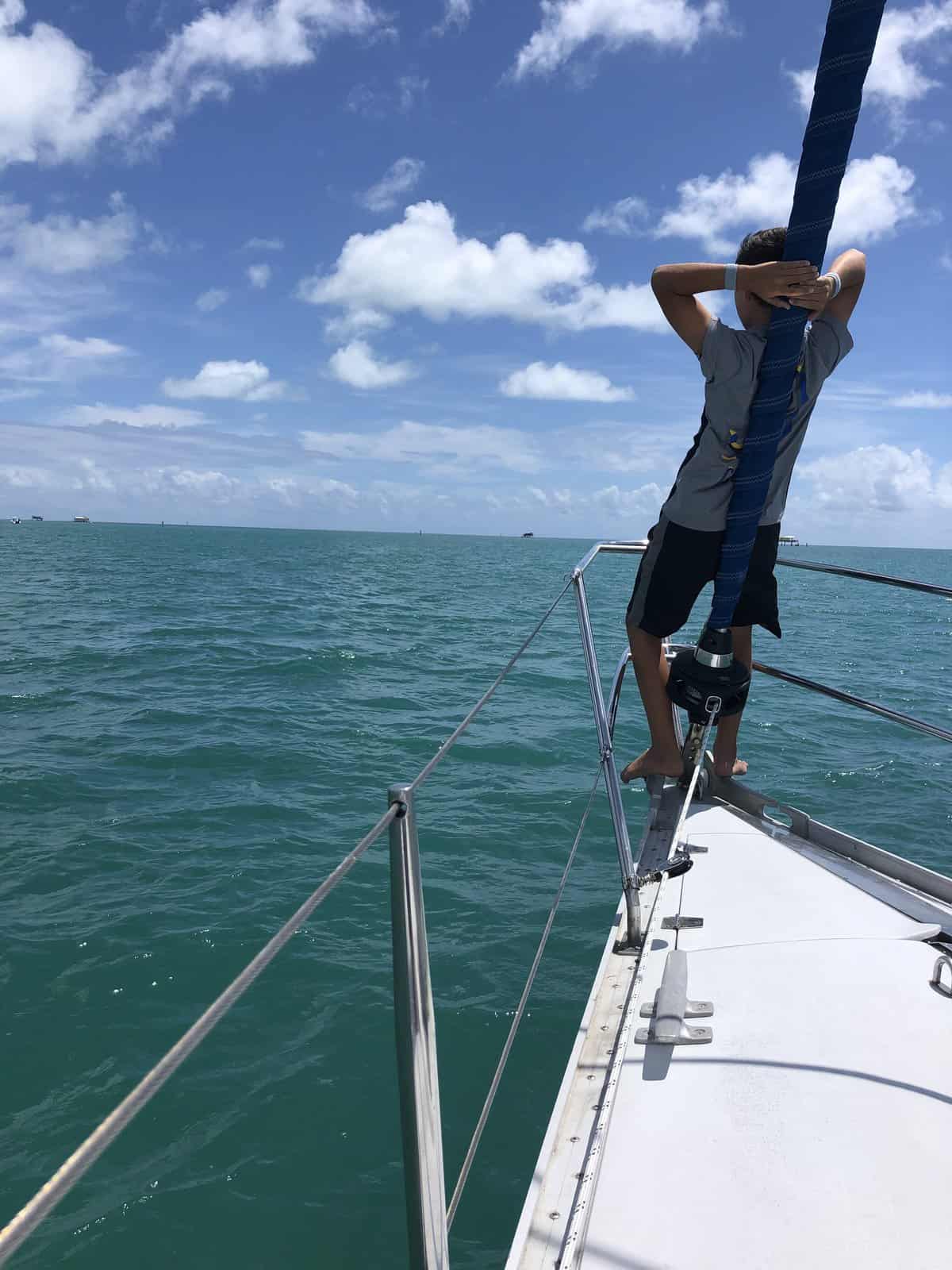
If a monohull flips, it will right itself fairly quickly (unless it starts taking in water). If it takes in water, a monohull will sink quickly.
It is likely the mast will break, before a cat capsizes. Once they flip over, however, they stay that way and turn into a raft.
Let’s be real, though. If the boat is truly in such daring conditions that it flips over, the injuries and damage are the real danger, for those still conscious.
Boater’s Tip: Avoid bad weather in the first place – use Predict Wind App, have a guide during longer passages. Avoiding a major storm is perfectly doable.
3. Cost
Monohulls are far more affordable than catamarans.
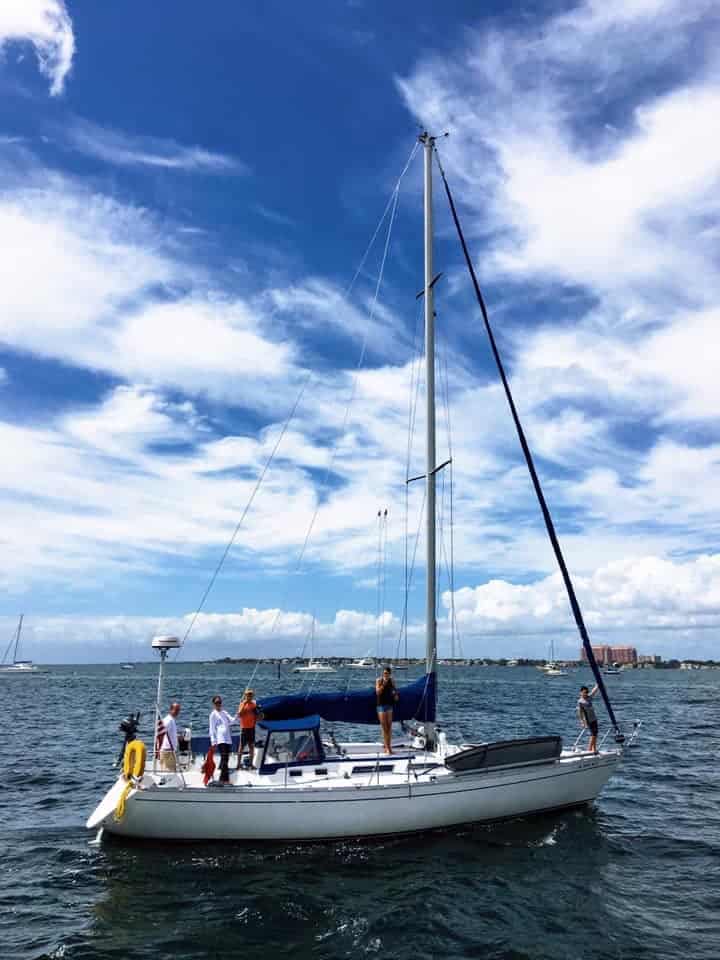
There are also a lot more of them to choose from, making it a buyer’s market in almost all cases.
It is not unheard of to offer half of what a monohull is listed for and be able to get a great deal.
Catamarans have always been more expensive, but especially in the last few years. With more people able to be location-independent, catamarans have become the first choice for a floating home, for many.
Buying a catamaran? Read this: Buying a Catamaran in 10 Steps – Complete Guide.
When we first moved on a sailboat, we still had our house and its large mortgage, and we were not sure if that boating thing was going to work at all. So, we only looked at monohulls and were able to find our 1985 Grand Soleil 39 at a very good price.
Once we decided to switch to a catamaran, low-balling went out the window. It was a hot cats’ market out there. We looked hard, made tons of calls, but most of all waited as long as it took.
Patience can pay off and is a good financial habit to adopt.
For more good financial habits: 12 Practical Ideas to Spend Less
The prices for cats have been staying high due to many people being willing to finance a boat, kind of like having a mortgage on a home.
It sort of makes sense, if the boat is to become your new home.
4. Resale value
Flipping a fixer-upper boat is a risky business. Few venture into it.

Monohulls and catamarans are like cars, they lose their value over time.
Sure, one can buy a fixer-upper of a boat, update all the systems and end up with a beautiful boat, but the cost of boat upgrades and repairs is very high. Unless you do most of the work yourself, return on investment is zero.
Even catamarans do not hold their value. You have to rely on a crash in the luxury items market, or a hurricane leaving lots of boats with reparable damage, to snag a good deal on a cat.
We lost money selling our monohull, but made money on our catamaran – we did almost all the work ourselves and it was a good market, so we took advantage. It did cut our cruising short, unfortunately.
Boater’s Tip: Sell your boat “by owner” and do the listing right – here is a whole post about it: How to Sell a Boat by Owner, the Honest Way
5. Maintenance
Plan for around 10% of the boat value for annual maintenance cost.

Monohulls only have one of each to run and fix – one engine, one hull to paint, one AC unit.
Catamarans cost more to maintain and expenses add up quickly.
In addition, it costs more to haul out a catamaran, as few boatyards are equipped with a sling to accommodate the width of a catamaran.
There are even fewer options in remote island countries.
Boater’s Tip: If sailing internationally, do just the urgent repairs at the US/other developed country. Cheaper destinations offer a lot cheaper services. Buy spares, they are hard to find in remote places.
6. Speed
Both or our boats have been designed with speed in mind.
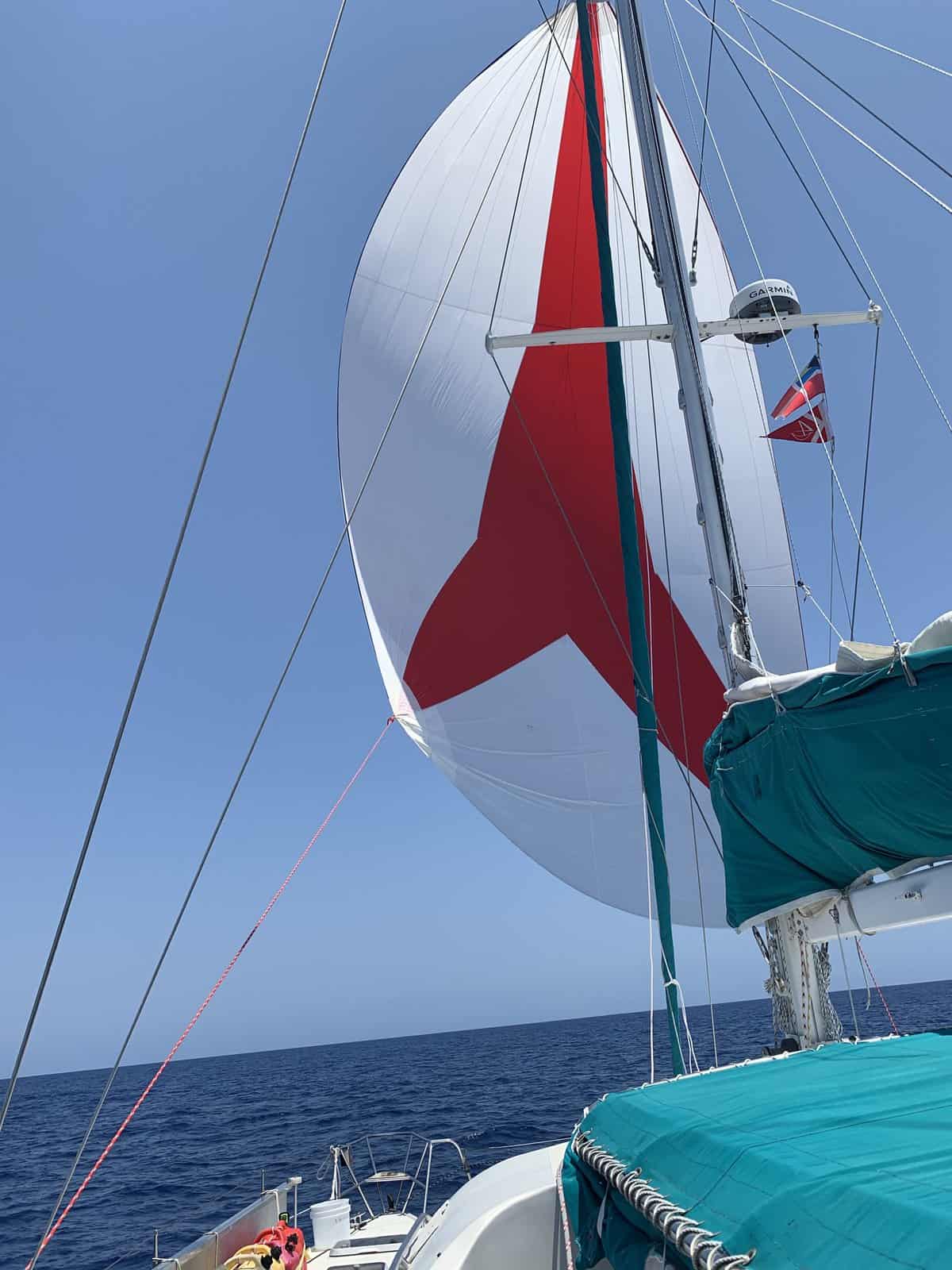
We have sailed at 11 knots downwind on our 42 ft Privilege catamaran. We usually reached 7-8 knots into wind, on our 39 ft Grand Soleil monohull.
That was in around 15-20 knots of wind.
Catamarans sail faster, with all other things being equal. A few factors contribute to higher speed in catamarans:
- Hull design and shape – the less of the hull in the water, the less drag.
- Lighter weight overall – aided by proper load distribution and boat material.
- The hull material, in performance cats – carbon fiber, or an inner foam layer.
- Larger sail surface area, calculated as the beam : length ratio.
A 50 foot sailing catamaran (and smaller), with proper hull and body design, can exceed 20 knots of sailing speed in 25 knots of wind.
More subjective factors that have major influence on the speed of both monohulls and catamarans:
- Boat load and distribution – lots of cargo means slower speed.
- Proper sails management – how much wind the sails can “grab” (I am a master of spilling wind on monohulls, because I hate going fast, call me for tips).
- Crew experience – wind speed and direction changes almost constantly. Sails have to be adjusted at the same rate, if you want to go fast.
- Cabin and cockpit design – the larger, higher and boxier that cabin / cockpit, the more it will slow down the boat.
Boater’s Tip: To increase boat speed during sail, buy folding propellers. Put the boat on reverse, so they don’t spin, to decrease drag. Just make sure you take the boat off reverse when starting the engine!
7. Wind feel
If you are starting new, with no sailing experience, start sailing a monohull.

A monohull allows you to be the one sailing the vessel. You can really feel the wind and gain a perfect understanding of how the wind and the sails work together.
Our monohull did not have an autopilot and even though overnight passages were hard, we became very familiar and comfortable with our boat. This is coming from a mama who never grew fond of sailing.
If going out for a day sail, for the sake of sailing, I would pick a monohull.
Catamarans are fast, but they kind of sail as they wish. It is almost impossible to feel the wind and its pull on the mast.
That is why catamarans are sailed by numbers – by reefing the sails following the manufacturer’s recommendations. With experience it becomes easier.
Boater’s Tip: Try sailing a monohull and a catamaran, to see the difference. Both will likely make you sick, so don’t let that be the determining factor.
8. Performance
I am discussing performance in terms of how the boat sails at different angles to the wind.

Monohulls sail great into the wind, making it easy to start a passage when the wind is blowing almost in your face. They achieve this by heeling over (leaning to one side).
Monohulls do not sail well downwind. You can have a spinnaker up, or spread the sails to grab the most wind possible, but it is hard for light apparent wind (true wind speed reduced by your boat’s speed, when sailing downwind) to move a heavy monohull.
Catamarans do not sail into the wind. Even performance cats need a winder angle into the wind to be able to move.
Downwind, catamarans will give you the most comfortable ride ever, while flying a spinnaker. That glass of wine they are talking about not spilling aboard – it is during downwind sailing.
Both cats and monos suck when sailed into beam wind (wind coming from the side). I know, I am not terribly technical here, but it feels like choosing between two evils – rolling and puking, or being jerked and puking.
Feeling sick? This might help: Seasickness Sucks – 21 Tried and Tested Tips to Stop it.
Boater’s Tip: Wait for a better weather window. Nothing can ruin a great adventure quite like sailing, scheduled by your calendar.
9. Maneuverability
When discussing maneuverability, I am featuring here behavior under sail.

Monohulls are very easy and responsive to tacking (changing the direction of the boat, while sailing upwind). All those movies where teams work in excellent synchronized movements to flip sails to the other side of the boat, show you examples of tacking.
Catamarans are hard to tack. They are very slow to respond, so you need lots of momentum and speed, as you prepare to tack. Once you wait a bit too long, the opportunity is gone. It is not a big deal, but in stronger winds, you can easily rip a sail when it starts flopping uncontrollably in the wind.
We are not fans of jibing on either boat (changing the direction of the boat during downwind sailing). True downwind sailing is never a good idea, because accidental jibing can hurt both the boat (done it!) and the crew, in stronger winds.
Boater’s Tip: No texting and tacking – teamwork pays off best when working together to sail against the direction of the wind 😉
10. Docking
The best part about docking is pushing off the docks. Marinas are expensive and the adventure is never, ever the same, if the boat is just tied in place.

Still, when considering docking keep in mind:
Catamarans are super easy to dock and can rotate a full circle on a very small radius. This is because catamarans have two engines and it is a breeze to control the boat, while using the engines to maneuver into tight spaces.
Monohulls are such a pain to dock; it was our captain’s biggest nightmare. We were all threading very carefully when it was time to dock our monohull. That momentum the boat gives you while tacking, works quite against you when docking.
When we purchased our monohull back in 2017, we found the tiniest, cheapest marina on the Chesapeake Bay, and sailed on the weekends, practicing docking.
Only the marina owners laughed at us (even though they never admitted it).
Boater’s Tip: We like casting the spring line first, when docking. Some marinas have ridiculously strong currents – call ahead and make sure someone is there to help.
11. Draft
If you want to jump off and swim to the beach, you need a catamaran.

The draft of the boat is the distance between the waterline and the end of the keel. This defines how deep the boat can go without hitting bottom.
Catamarans are lighter and have a shallower draft, compared to monohulls. From around 3ft for a cat under 40ft, to around 6ft for larger catamarans. Our Privilege 42 drew 3.5ft.
Catamarans can go in shallower water. They can even be “beached”, meaning, you can actually take the boat all the way to the beach, then use the high tide to bring her back into the deeper water. Just ensure the access is free from any rocks and coral.
For the times you “beach” the boat accidentally, make sure you have towing help.
The photo above is from us sailing the Great Bahama Bank – an amazing shallow plateau that only a catamaran can handle.
Monohulls have a longer keel, which helps stabilize the boat. The keel must go fairly deep, in order to “hold” a monohull upright, and to counter the wind force on the sails.
The most common keel types you might see are:
- full-keel – a keel looks like a natural extension of the keel. It provides great stability, but makes the boat heavier and slower.
- fin keel – a keel that looks like a fin, attached to the bottom (the most common kind), for stability without sacrificing speed.
- lifting keel – An adjustable keel to change the draft of the boat, if needing to navigate shallow water. They are convenient, but not as sturdy.
Our 39-foot monohull drew 6 feet – quite a lot for such a small boat. It did limit our anchoring options.
We have seen both catamarans and monohulls stuck, by running aground. It is possible to free up the boat, if you are careful with the engines and don’t end up digging yourself deeper.
We had a Boat US membership the entire time we were coastal sailing the US. They even rescued our dinghy once.
Boater’s Tip: We always set our depth instruments to show smaller than actual depth, giving us a cushion with the uneven sea floor.
12. Cruise comfort
Comfort at anchor matters most, but a miserable passage can ruin the entire adventure very quickly.

So, let’s talk about passages – seasickness, heeling, slamming, rolling, keeping watch…
Seasickness happens both on catamarans and monohulls. We found it worse on catamarans, contrary to popular belief. Anything but downwind sailing makes the catamaran turn and twist in ways that only make sense to a catamaran.
The jerking of the catamaran almost feels like riding a tractor on a very bumpy road, but without the chance to stop and rest. On top of that, waves slamming under the boat (even with higher clearance), make the entire boat shake.
Seasickness on a monohull is an absolute given in beam winds. The entire boat rolls from side to side, with every single wave and such passages are downright miserable.
Heeling is a must on a monohull, if you wish to go anywhere. While this is great for speed, it makes life at an angle uncomfortable.
Personally, healing always freaked me out. I feared a kid might fall out of the boat and chased everyone below deck (where seasickness eagerly awaited).
Sleeping on a catamaran during passages is hard, because the slamming of the waves below is too loud and disturbing. I never got used to it.
Sleeping on a monohull during passages is actually a bit better, once you fall asleep. The movement of the monohull is predictable, which can, actually, rock you to sleep.
Boater’s Tip: Buy a Reliefband! All of us got seasick, every single passage. We tried everything. Nothing worked like Reliefbands, and they come with zero side effects.
13. Comfort at anchor
The art of anchoring must be learnt along with the art of sailing. Otherwise damage to other boats is quite possible. Anchoring is simple math and common sense.

Catamarans behave much better at anchor, compared to monohulls. They are more stable and not affected as much by a wrap-around swell (when the waves are coming from the side, while the boat is facing into the wind).
Considering cruising is 99% standing still, it is not hard to understand why this single advantage can negate everything else.
Cats tend to “sail” on their anchor, meaning the boat may move about, being pushed by the wind. Just something to keep in mind in a tight anchorage.
Monohulls will roll a lot more at anchor, if the anchorage is not super calm. We have been seasick at anchor a few times, which the kids loved, because those “wind days” meant “no school aboard”.
Monohulls can counter wrap around swell by bridling – dropping a second anchor off the bow, in order to keep the boat facing into the waves, rather than into the wind.
No matter what boat you end up anchoring, keep in mind that with the changing wind, the boat position will also change.
Oh, and watch the boat behind you, please (yes, I’m talking to you, St. Thomas guys, on that chartered boat).
Boater’s Tip: a good rule of thumb, for normal sea conditions, is 5:1 – five feet of chain for every foot of depth.
14. Indoor space
The indoor space is a huge factor for many, when shopping for a sailboat.


It mattered a lot to us, as well. The most important things to keep in mind are:
- Space
- Light
- Ceiling height
- Privacy
I have a popular post all about space on a boat: Why We Never Missed Space, While Living on a Sailboat.
Catamarans have more indoor, living space, compared to monohulls (for same length boats). This should come as no surprise. The salon and hulls together make the cat feel like a cute apartment on the water.
Catamarans offer a much better view and lots of light. Monohulls offer no view, but they are not dark, because the hatches act like skylights. The photos, from our boats above, prove just how bright a monohull is.
If you want more of a performance cat, then the view will be sacrificed a bit, because the cabin must be curved and relatively low, to avoid extra windage.
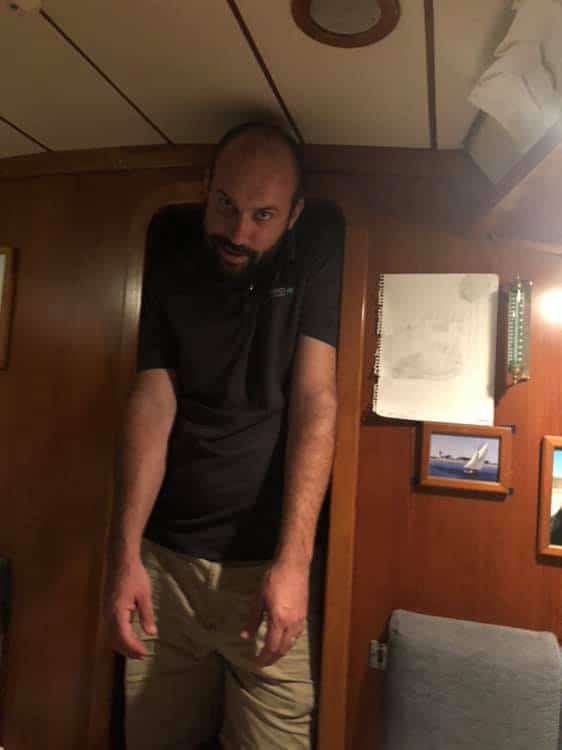
Only certain model catamarans and monohulls will have ceilings suitable for tall people. Joe is 6’4″ and the only catamaran under 43 feet, which would accommodate him, was the Privilege.
Catamarans offer a perfect separation of living space and private cabins. Monohulls with a center cockpit do have a nice aft cabin, but everything else is tight, or a bunk-style closet. Again, focusing on boats under 45 feet.
With three teens aboard, privacy was high on our list. We loved the separate heads (bathrooms) for each hull, although having four of them aboard is excessive (we turned one into the laundry room, and another into a shower room).
Boater’s Tip: Do consider catamarans with the galley below – I loved it! You get a ton more counter-space, and the salon above is more spacious.
15. Outdoor space
Considering most boats sail in warm climates, the outdoor space is a crucial factor, when shopping for a boat.
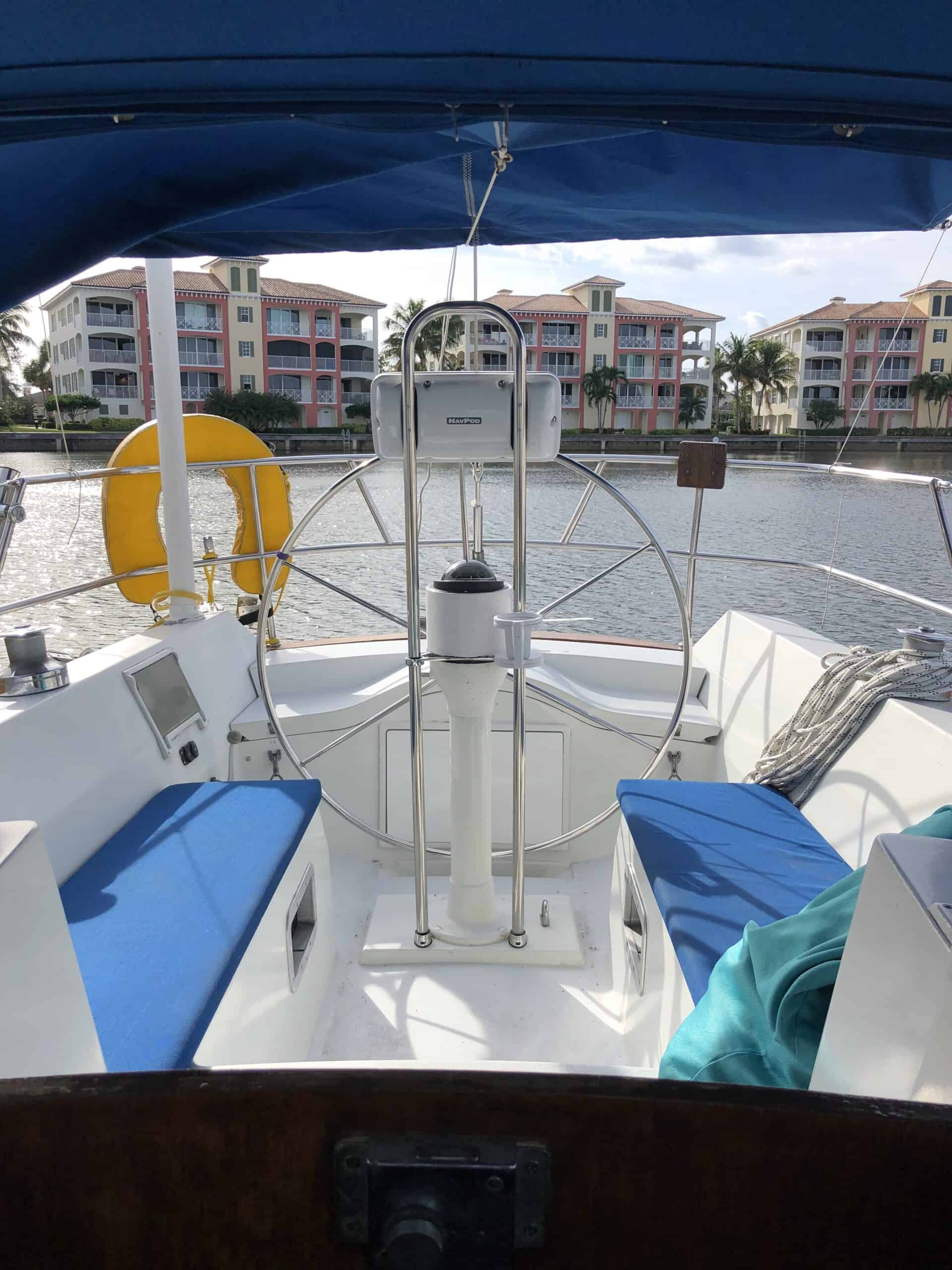

Catamarans offer much, much better outdoor space, compared to monohulls. The cockpit was my favorite space, on our Privilege.
Unlike the patio of a house, the outdoor space of an anchored boat provides constant breeze and zero bugs (occasional bee swarms might happen in some places).
Another point for the catamaran is the bow trampolines, which are a favorite hang-out spot. It is easy to send the kids and their friends to the front, while the adults hang out in the cockpit.
With older kids, however, we just left them all boat-alone, while the adults gathered on a different boat.
Walking on deck during passages is easier on a catamaran, because the boat does not heel.
16. Sustainability
Sustainability is all in the hands of the crew, much like safety. It is never the boat’s fault, if the crew wants to motor, instead of sail.
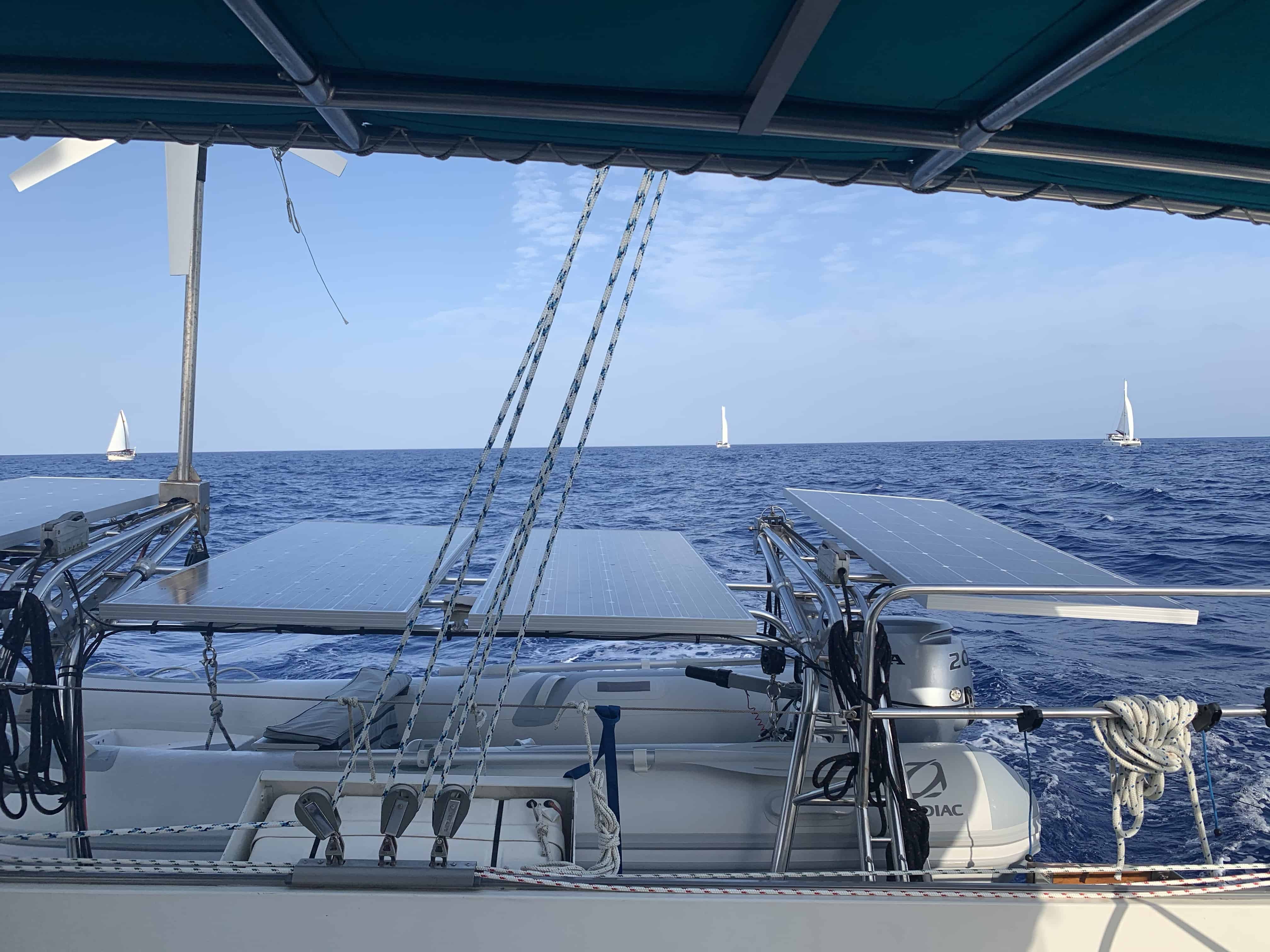
Both catamarans and monohulls have plenty of surface area to attach solar panels and wind generators.
You will like this post: This Sustainable Lifestyle is the Fairest of Them All. 10 Reasons Why Living on a Sailboat Matters.
A few boating families we met swore by their solar ovens too. I bought a super cheap one and never got it to cook anything, but granola.
As far as the cats having two engines – many motor using only one of them, and the one engine aboard a heavier monohull uses plenty of diesel too.
Boater’s Tip: Forget the generator. They are super noisy and use lots of diesel. When you are at anchor, there is a constant breeze. Buy wind scoopers instead.
17. Fun and entertainment
Our kids were happy, as long as there were other boatkids. So, that should be on the top of the priorities’ list.

I have an excellent post on socializing the kids while on the water:
Sailing and Socializing Kids – 8 Ways to Find Friends on the High Seas.
Having said that, our catamaran was much more comfortable to invite company over, compared to our monohull.
Catamarans have an excellent division of space – both indoor and outdoor. Not to mention that on a hot day, a swim platform can go under the trampolines for shade!
Monohulls are best for swinging and playing catapult games, but they are not great for entertainment.
We have had family visit aboard our Privilege, and it did not feel crowded at all.
Boater’ tip: Be the party boat, at the anchorage, if you have kids, this will make them enjoy boat-life more.
18. The looks
Beauty is in the eye of the beholder. Captains are not the only beholders.
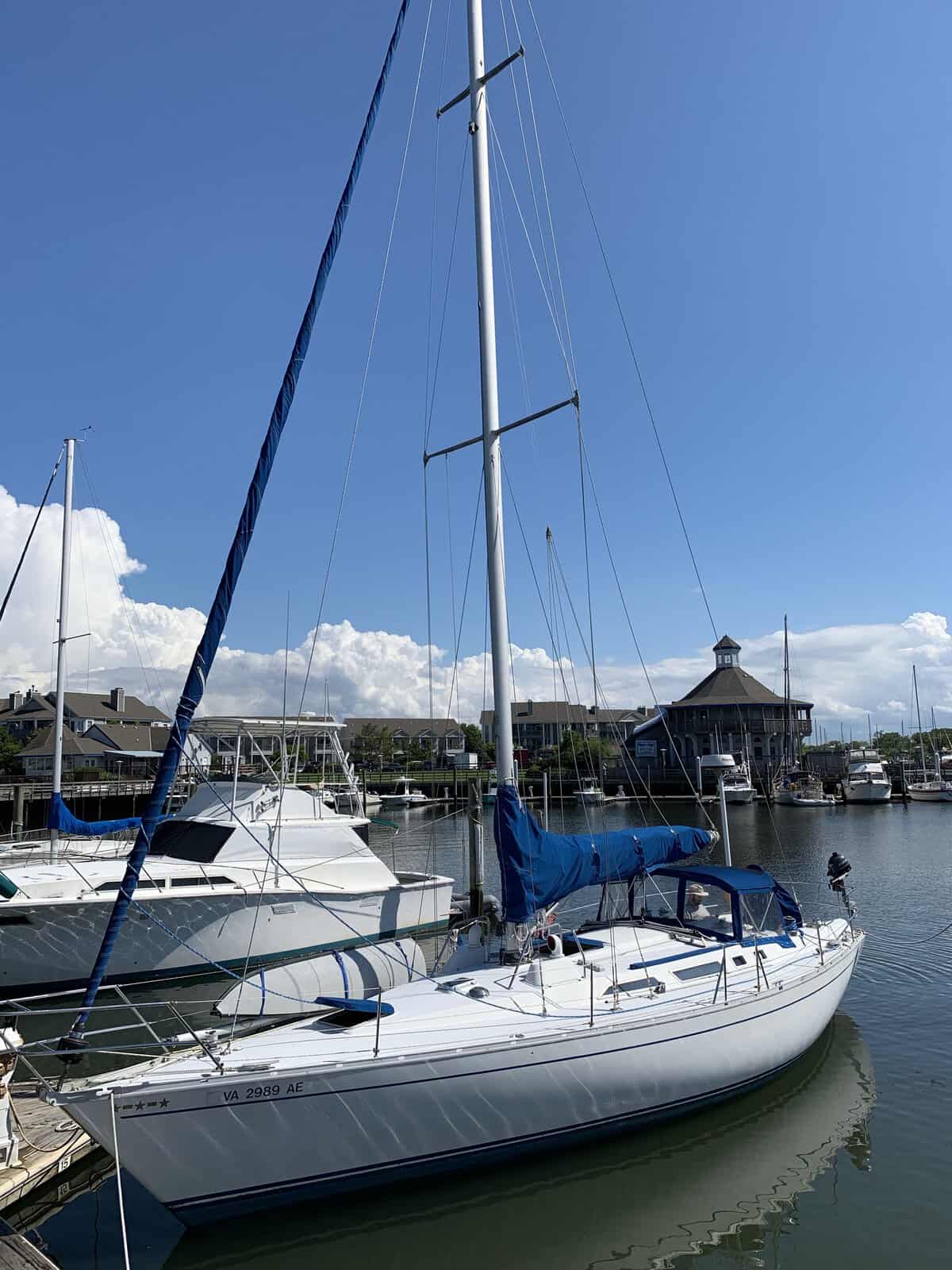
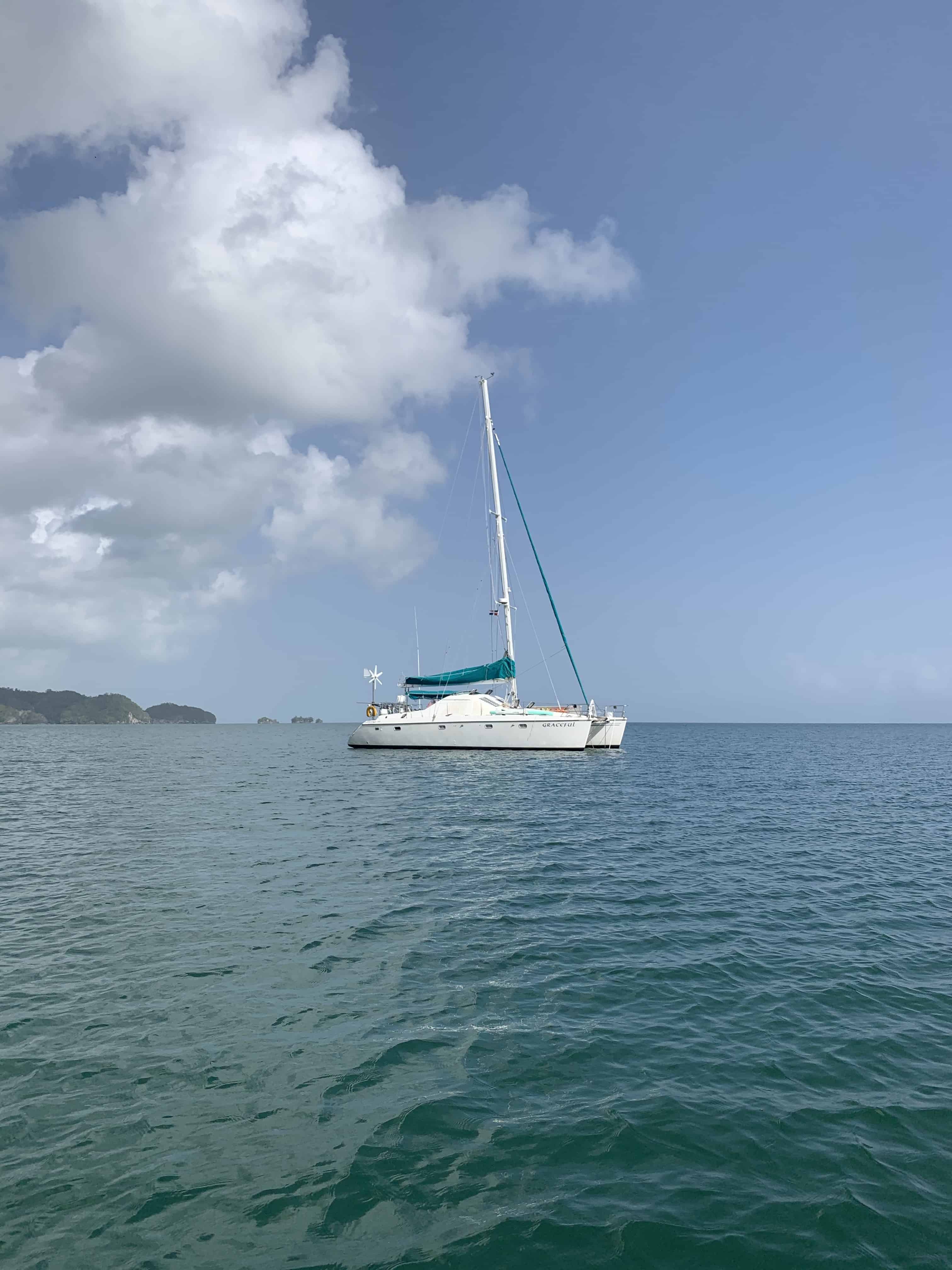
Both monohulls and catamarans can look amazing, or ridiculous. We liked both of our boats, the captain actually loved them both, which put me in a perpetual love triangle.
To be perfectly honest, Graceful was a better suited name for our Grand Soleil Monohull. We were not able to come up with a better name, and everyone knew us as the SV Graceful crew, so we kept the name for our catamaran.
There is also some romance surrounding the looks of a monohull, from paintings and movies, so I’ll give the beauty point to the monohull.
Boater’s Tip: Pick the one, which will make your wife less jealous.
19. The crew
Unless you are solo-sailing, you must consider the wishes of the crew.

When we first looked at boats, catamarans were out of the question, because they were expensive, and our captain thought they were ugly.
Three years later, two of which full-time living aboard our monohull, the boatkids spoke! They wanted to continue sailing, but on a catamaran. And we listened.
Check out the full story of our crazy adventures
In the end, we are the parents and there are decisions as well as consequences, which are not OK to dump on the kids.
But the crew is a true team on the water. So, everyone’s opinion matters (which is also why we returned to land life).
What is the right boat for you?
Now that we have talked about the differences between the two boats, let’s see which one might be right for you, at this stage of your adventure.
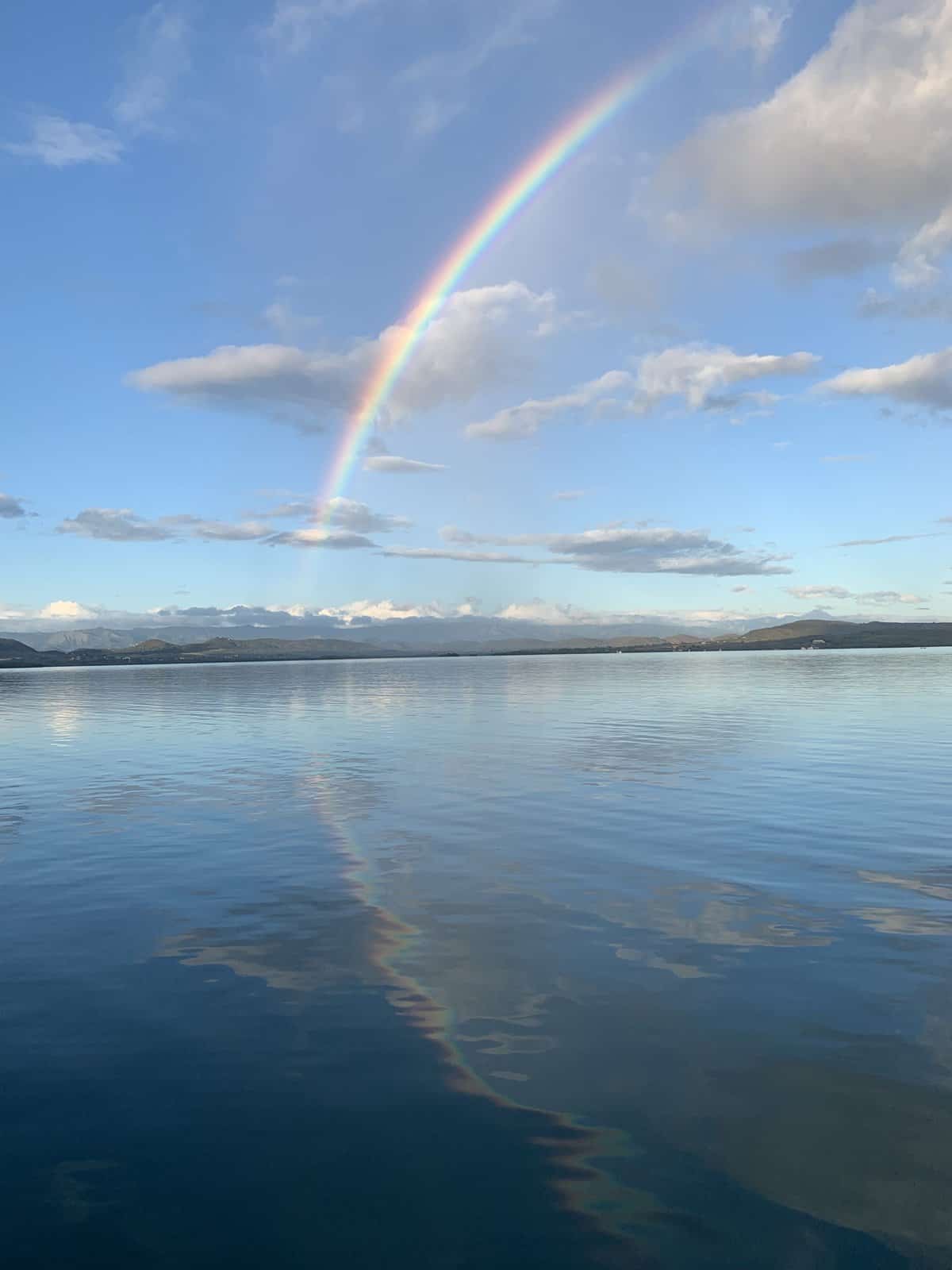
Sailing with family
We believe that a catamaran is the best choice for a family, especially when traveling with older kids.
Teens will love the clever separation of space with cabins, providing plenty of privacy.
Our favorite Privilege, actually has a fully enclosed cockpit, for added safety.
A monohull might be best for couples with toddlers, requiring help and constant supervision (got for one with a centyer cockpit).
When the need arises, for both people to be handling the sails, it usually requires one’s full attention and a kid on a catamaran can run out of sight quickly.
The best thing you can do, if no other factors are at play, if to hop on both sailboats, enjoy a day-sail trip, then discuss it with the crew.
Sailing as a couple
A monohull would be the better choice for a physically fit couple, sailing without kids (or with young ones).
Owning a monohull is cheaper, and a couple might have the budget to stop at marinas more often and explore places in-land.
A retired couple might find a small catamaran more comfortable. The acrobatics and strain to sail at an angle, climbing in and out of the salon, as well as climbing on deck do require agility and a healthy body.
Sailing solo
It is hard to beat a monohull, if sailing solo.
If the boat is rigged for solo-sailing, the smaller cockpit of a monohull provides great space to handle the lines. Especially, if the instruments fail.
One person can solo sail a catamaran that is no bigger than 40 feet, with a small cockpit and rigged for solo sailing. Hop in the cockpit of a desired cat and try grabbing the lines on either side, alone, from the cockpit. Can you do it?
Sailing lifestyle
If planning to do lots of cruising, then either boat would be fine, depending on your preference, considering all the things mentioned above.

If planning to live mostly at marinas and travel to explore land, maybe a monohull is better, offering a lot more options for marinas at a lower cost.
If you need to haul out the boat frequently, during hurricane season, a monohull would be easier and cheaper.
Catamaran at a mooring field, in an expensive location, will grant you those million-dollar views, from your living room, for a small fraction of the cost that people pay ashore.
We loved Coconut Grove, Downtown Miami, USVI, from our quiet, private and affordable boat.
Speaking of waterfront living, I have a great post about living on a boat:
Can you Live on a Boat? Yes, and Now is the Right Time
Just chartering for vacation?
A catamaran will be the better chartering option, if you are just sailing out for a week, or so. Here is why:
- Great views from the salon.
- Better separation of space, if diving the cost with another party.
- Larger space for entertaining.
- Easier to get in and out of the water.
- Catamarans are a lot more comfortable when anchored, than monohulls.
- Motoring between anchorages can get you there faster.
- You can anchor closer to the beach, because of the shallow draft on a cat.
What other boaters say.
Still uncertain? Check out the praises sung to both monohulls and catamarans below – all by our dear friends, who have sailed extensively and know what they are talking about.

Praises to the mono
SV Silent Thunder, “Mono- smoother ride as she cuts through the sea.”
SV Lady of Mettle dad, “I prefer monos. I never seen the need to go over the same wave twice. Mono’s are a more predictable swaying motion. Cats feel unpredictable and “twitchy” to me. Monohulls handle weight better than cats. If blown over, monos stand back up. Cats don’t.”
SV Lady of Mettle mama, “When we sailed a Cat with family in Key West, I didn’t like that the helm was outside and upstairs. In foul weather that would not be great along with always having to be outside to helm. In comparison we have an inside helm to get out of sun or weather. I also did not enjoy the bow, outside on the deck was not as enjoyable to watch he dolphins play, and the smallest wave splashes over, keeping you in the back while sailing.
Overall sailing, I think a Monohull, but staying still, probably a cat just because of the open galley and living room areas.
My boat has plenty space however, a cat would not hold our things. Also, cats all look the same. Also 2 hulls to clean and scrape…booo The Cat has to go overboard.”
SV Traveler, “I would like the additional living space on a cat but I really like that my husband can captain our monohull by himself and if we need dock space or a haul out it seems easier to find with a monohull.”
SV Island Cartouche, “Mono – smoother ride, affordability, more romantic look on the sea, and not enough room … ![]() lol”
lol”
Praises to the cat
SV Half Dozen, “CAT allows for view and comfort at anchor.”
SV Varekai, “…I can honestly say that (monohull) it’s not as comfortable. Cockpit, salon, berths…we all feel less comfortable on the mono. I also miss being up where I can see out. The sugar scoops were nice for when docked and sailing. I’m not a fan of boarding on the side as much.”
SV Mojo, “Straight and smooth sailing no healing. I would hate having to be angled while moving. Loved the space inside and out. There’s a compromise in everything but that worked for us for a bit anyway, because then I needed more space. If you give a pig a pancake…right?!”
SV Colibri, “We love the room, light and layout of our cat. We rarely sway at anchor. It’s nimble and has enough space and privacy for a family with two teens (and a cat!). It can be single handed. The mast is 63″ so we can take the ICW. All in all, a dream boat (FP Lipari).”
SV Snowless, “Love the cat. Would definitely take the cat over a mono for most of the time. Yes the mono is great for going to to the wind aka, getting from us to Caribbean, but that is only a small portion of the travel. After that it’s mostly beam or downwind sailing. The trade off for being at anchor which is where you spend most is your time is unmatchable in my opinion.
However, when going upwind and I look ahead and see a mono healed over cutting through the waves with this mast holding steady, vs me and my mechanical bull that I am riding, I am envious.”
SV Aquafox, “I liked all the different living spaces we had on ours. I really liked the stability of it vs the movement you can get on a mono. Monos are awesome on speed and price though.”
Tours of our boats
Below are links to our boat tours, as well as episodes on Youtube, showing our boats, enjoy:
Our Catamaran Tour – 1995 Privilege 42
Our Monohull Boat Tour – 1985 Grand Soleil 39
Our 1985 Privilege 42 For Sale Video
Our first few YouTube episodes feature our monohull
Conclusion
In the end, I propose that Catamaran vs Monohull Battle be renamed to Sailor vs Sailor Battle.
It really matters most what kind of cruising the sailor wants to do, and what matters most to the crew. And, just like in real battles, sides can be changed.
So, let’s focus on the crew and leave the poor cat and mono alone.
Links to what we recommend in this post
- Reliefband – excellent against seasickness. Zero side effects, we loved them.
- Sailing classes via the American Sailing Association
- Predict Wind – to always select the best possible weather window.
- Folding propellers – to help increase boat speed and protect the propeller.
- Boat US Membership – for peace of mind, while sailing the US coast.
- Wind scooper – for extra breeze inside the cabins – a must aboard!
Helpful posts about boating life
Buying a Catamaran in 10 Steps – Complete Guide.
Pros and Cons of Living on a Boat. By Experienced Boaters.
The cost of living on a boat for a family
